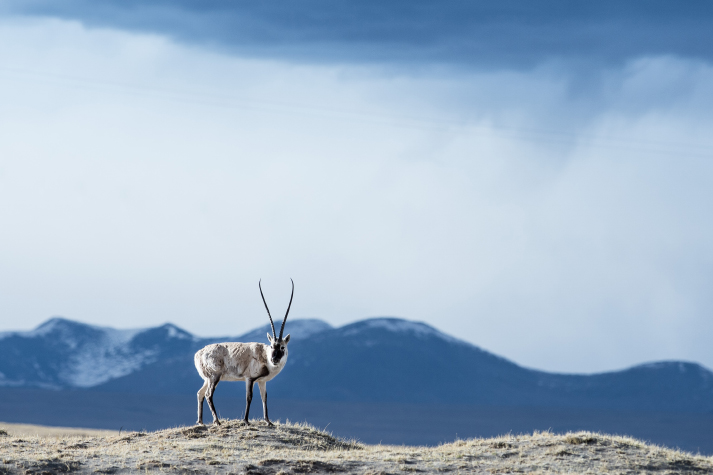|
||||||
|
||||||
| Home Nation World Business Opinion Lifestyle China Focus ChinAfrica Multimedia Columnists Documents Special Reports |
|
||||||
|
||||||
| Home Nation World Business Opinion Lifestyle China Focus ChinAfrica Multimedia Columnists Documents Special Reports |
| Nation |
| Wildlife Refuges |
| National parks are being built in China to better conserve endangered animals and the ecosystem |
| By Yuan Yuan | NO. 45 NOVEMBER 8, 2018 |
 A Tibetan antelope seeks food in Hoh Xil in Qinghai Province on May 19, 2015 (XINHUA)
Pandas that are currently scattered among a few isolated and relatively small nature reserves in China are expected to have a new and much larger home by 2020 in the country's first Giant Panda National Park. In a further step in the planning process, the administration bureau of the park was officially established in southwest China's Sichuan Province on October 29. The park—spanning the three provinces of Sichuan, Gansu and Shaanxi—will cover an area of 27,134 square km, triple the size of the United States' Yellowstone National Park. The panda habitat area will encompass 18,150 square km, with 1,614 giant pandas in residence. "Giant pandas will be the major species under protection in the national park. In addition, more than 8,000 kinds of wildlife, including snub-nosed monkeys, will also be covered in the protection," explained Su Zonghai, Director of the bureau. "The national park will not only boost the population of wildlife in the region but will also protect their habitat for better biological diversity." At the moment, China has 67 nature reserves for the protection of giant pandas, according to the bureau, and the wild giant panda population has increased from 1,114 in the 1970s to 1,864 today.  Siberian tigers in the Siberian Tiger Park in Heilongjiang Province on July 17, 2017 (XINHUA)
A national act "It has been 15 years since I first proposed the establishment of a national park for pandas," said Sun Qian, a renowned expert on giant pandas and the former Vice Mayor of Yaan City in Sichuan. Sun visited the United States to study the operating experience of national parks and came back with the idea of building a national park for pandas in China. He submitted a proposal in 2003. However, his plan didn't get any feedback until 2013, when the Sichuan Provincial Government initiated a national park project based on his proposal. The suggestion was well-received by the Central Government. The area for the planned national park was later expanded to include two other provinces and in December 2016, the scheme to pilot a national park for giant pandas was formulated. More than 80 preservation areas in the covered territory will be fused with the national park to help the endangered animals mingle and strengthen their gene pool, bringing together pandas that are now isolated on six mountains in the three provinces. The park is one of the 10 national parks set to open by 2020. They are planned to include some of the country's outstanding scenic spots and put endangered animals under better protection. The national parks will cover areas from the heights of the Qinghai-Tibetan Plateau to the foot of the Great Wall outside Beijing. Mainly aiming to protect China's large natural ecosystems, the government plan lays down that the national parks would be on specific land, and in marine areas to achieve a combination of ecological protection and sustainable development. The Sanjiangyuan National Park, which piloted the project before the plan was even released, has already been in trial operations since 2016. Literally meaning the source of three rivers, Sanjiangyuan, a vast wetland and grassland area located in the southern part of northwest China's Qinghai Province, is the place where the headwaters of the Yellow, Yangtze and Lancang (Mekong) rivers originate. In 2000, the Sanjiangyuan Nature Reserve was established in Qinghai, but due to human activities such as overgrazing, the environment degraded. As a result, in 2016, the administration bureau of the Sanjiangyuan National Park started trial operations to increase the park's green coverage and wildlife species, which include endangered animals such as the Tibetan antelope and the snow leopard. "So far, the operation has been proceeding smoothly and the ecological environment has been upgraded dramatically," Li Xiaonan, Director of the Sanjiangyuan National Park Administration Bureau, said. All development and construction that could hurt the ecosystems will be prohibited in the 10 national parks, and illegal mining, pollution and poaching will be punished. To make way for the national park for the endangered Siberian tiger and Amur leopard, northeast China's Jilin Province has abandoned plans for a new expressway and changed the route of a high-speed rail line. The park, covering 14,600 square km—almost the size of Beijing and five times the size of all of China's existing big cat reserves—will sprawl across Jilin and Heilongjiang provinces and the border with Russia. It is a response to the population crisis threatening the two big cats due to human encroachment and the loss and degradation of their habitat. A team of big cat researchers from Beijing Normal University, led by professor Ge Jianping, worked to provide a clearer picture. After a decade of field surveys, including recording data from thousands of infrared cameras, they estimate that between 2012 and 2014, at least 27 Siberian tigers and 42 Amur leopards were active within China's borders.
Zhangjiajie in Hunan Province on July 16 (XINHUA)
More unified management Since the first batch of nature reserves were established in the late 1950s, China now boasts about 10,000 protected areas. But a unified system has never been set up to regulate and safeguard these regions. Fragmented management and insufficient funding are threatening most protected areas' conservation efforts. Part of the problem lies in the complex administration of eco-zones. Authorities in charge of agriculture, forestry, land use and environmental protection have at times confused their functions in operating the nature reserves. In an effort to solve these issues, the Overall Plan for Building a National Park System was released in September 2017. It states that China should form a unified management system by 2020. "The national park program will reduce fragmentation of habitats for protected species and protect fragile ecosystems in their entirety by centralizing oversight," according to the document jointly issued by the State Council, China's cabinet, and the Communist Party of China's Central Committee in late September. The Sanjiangyuan National Park, for example, has formed a new kind of integrated management system, with personnel separated from all other government departments. This represents a stark contrast to China's existing system of protected areas. Furthermore, the Giant Panda National Park, stretching across three provinces, will be directly under the management of the Central Government instead of local governments. "The current management system should be improved to remove restrictions imposed by different authorities," Su Yang, a researcher with the Development Research Center of the State Council, said. This new coordination will help ensure the long life of China's giant pandas and other endangered species, while at the same time it will protect the delicate and beautiful ecosystems found throughout the country.
An aerial view of part of the Pudacuo National Park in Yunnan Province on July 18 (XINHUA) 10 National Parks for Pilot Operation by 2020 Sanjiangyuan National Park (Qinghai Province) Giant Panda National Park (Sichuan, Gansu, Shaanxi provinces) National Park for Siberian Tigers and Siberian Leopards (Heilongjiang and Jilin provinces) Shennongjia National Park (Hubei Province) Qianjiangyuan National Park (Zhejiang Province) Mount Nanshan National Park (Hunan Province) Mount Wuyi National Park (Fujian Province) Great Wall National Park (Beijing) Pudacuo National Park (Yunnan Province) Mount Qilian National Park (Qinghai and Gansu provinces) Copyedited by Rebeca Toledo Comments to yuanyuan@bjreview.com |
About Us | Contact Us | Advertise with Us | Subscribe
|
||
| Copyright Beijing Review All rights reserved 京ICP备08005356号 京公网安备110102005860号 |